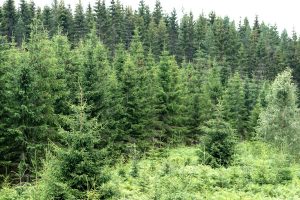The forest bind carbon dioxide (CO2) as it grows. E.g., in Sweden, 1 cubic meter of wood bind in average about 900 kg (0,9 tons) carbon dioxide, which make it a very efficient carbon trap. The more living trees we have in the forest, the more carbon it binds, but the trees have to be alive to achieve that. Shouldn´t that be worth something?
Photo: Per Jonsson
Carbon sink have a financial value
The storage of carbon in the forest should have a value that the forest owner can gain from. In general, the carbon sink has a very large value as it can adjust the balance of carbon dioxide (CO2) in the atmosphere. An example of that in the EU, is the emission trade where industries can sell their unused emission rights. This shows that there actually is a financial value here.
Value according to the price of emission
One can make it simple and just look at the transport sector (not railroad, sea and air). Here in Sweden, we have a CO2 tax on petrol and diesel, but not on biofuels, meaning that the state actually has set a value to the carbon sink. The total CO2 emission from domestic transports in 2018 was 15 263 million tons. The total CO2tax income from transports (petrol and diesel) the same year was 19,44 billion SEK (Swedish Krona). That gives a tax value of 1 274 SEK per ton CO2 (railroad, sea and air excluded).
How much CO2 does the forest bind?
Different tree species binds different amounts of CO2. An average Swedish forest (mainly Scots Pine and Norwegian Spruce) bind a little less than 1 ton CO2 per cubic meter, let´s say 0,9 tons. That means that the Swedish forest have a carbon sink value of 1 147 SEK (approx. 110 EURO) per cubic meter. That is much more than the value of sold timber in Sweden.
Could this be true?
Well, it´s simple mathematics, but very theoretical. The Swedish state will most likely not trade away their entire CO2 tax income to the forest owners just like that, not even for the environment. Especially not when taking into consideration that the forest industry wants the wood to process and sell, which also gives more tax income to the state.
But a well-managed forest binds more CO2 than a forest where nothing is done. A well-managed forest grows faster, and the more it grows, the more CO2 it binds. If nothing is done, there will be much dead and rotten wood in the forest, and rotten wood releases the CO2 out in the atmosphere again. So, if we can figure out a way to calculate how much more CO2 that is trapped in the well-managed, growing forest compared to the not managed forest, it might be fair to pay the forest owners for the difference? If nothing else, it will probably bring more well-managed forests.
The CO2 stays in the wood
It has to be mentioned that the CO2 stays in the wood also after it has been processed. That´s one of the reasons why wooden constructions, furniture, houses and other wood constructions, are healthy for the environment. The CO2 in wood is not released until it burns or rots.
The CO2 also stays in paper and paper products, but those are normally short rotation products (not used for a long time). Paper products are therefore not as good as wood from an environmental perspective.












